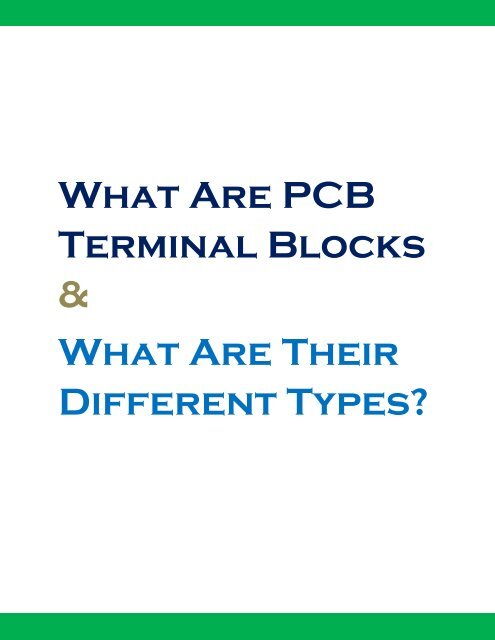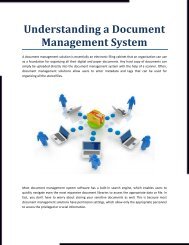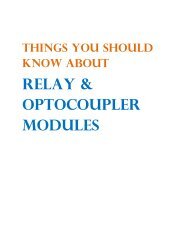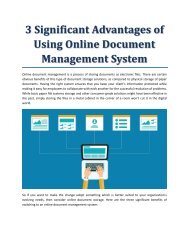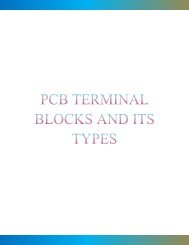What Are PCB Terminal Blocks and What Are Their Different Types?
PCB terminal block is a modular, insulated device which mounts on printed circuit boards (PCBs) and secures two or more wires together. PCB terminal blocks are used for securing and terminating wires and, in their simplest form, they consist of several individual terminals that are arranged in a long strip. Visit- https://bit.ly/2HXJ0K4
PCB terminal block is a modular, insulated device which mounts on printed circuit boards (PCBs) and secures two or more wires together. PCB terminal blocks are used for securing and terminating wires and, in their simplest form, they consist of several individual terminals that are arranged in a long strip. Visit- https://bit.ly/2HXJ0K4
Create successful ePaper yourself
Turn your PDF publications into a flip-book with our unique Google optimized e-Paper software.
<strong>What</strong> <strong>Are</strong> <strong>PCB</strong><br />
<strong>Terminal</strong> <strong>Blocks</strong><br />
&<br />
<strong>What</strong> <strong>Are</strong> <strong>Their</strong><br />
<strong>Different</strong> <strong>Types</strong>?
<strong>PCB</strong> terminal block is a modular, insulated device which mounts on printed circuit<br />
boards (<strong>PCB</strong>s) <strong>and</strong> secures two or more wires together. <strong>PCB</strong> terminal blocks are<br />
used for securing <strong>and</strong> terminating wires <strong>and</strong>, in their simplest form; they consist<br />
of several individual terminals that are arranged in a long strip. These terminal<br />
blocks are useful for connecting wiring to the ground or, in the case of electrical<br />
power, used for connecting electrical switches <strong>and</strong> outlets to the mains.<br />
<strong>Types</strong><br />
<strong>PCB</strong> terminal blocks are classified on the basis of their structure <strong>and</strong> device type.<br />
Structure <strong>Types</strong><br />
Single Feed Through<br />
This type represents the basic type of terminal block, <strong>and</strong> they are used in wireto-wire<br />
connections. Single feed terminal blocks have the one input <strong>and</strong> one
output contact. In these two distinct wires are fed into either side of the terminal<br />
block, <strong>and</strong> they’re connected within its housing.<br />
Dual Level<br />
These types have another level of connection terminal that is stacked on the first<br />
one. This arrangement is generally used for saving the space.<br />
Three Level<br />
Just like dual level terminal blocks, they have an extra level at the top. An<br />
advantage of using these multilevel blocks is that with these blocks, multiple<br />
connections can be made in the same block.
Device <strong>Types</strong><br />
Ground circuit terminals- They are used to ground components or<br />
systems. These are typically interchangeable with the st<strong>and</strong>ard terminal blocks<br />
<strong>and</strong> can be inserted into the block as <strong>and</strong> when needed.<br />
Fuse holdersdevices.<br />
So, when there is a short circuit, only the wiring sections connected to<br />
They connect several fuses associated with the number of<br />
the fuse holder gets affected.<br />
Thermocouple blocksto<br />
provide consistent metal connections to measure the<br />
These are used for connecting thermocouples <strong>and</strong><br />
temperature.<br />
I/O blockscontroller.<br />
They are used for communicating between the device <strong>and</strong> the<br />
Sensor/actuator blocksdevices,<br />
such as proximity sensors <strong>and</strong> photoelectric<br />
These blocks h<strong>and</strong>le three to four wired<br />
sensors.<br />
Power distribution blocks- They are used for terminating power cables.<br />
Disconnect blocksby<br />
using a knife switch <strong>and</strong> without removing wires. These are also known as<br />
These blocks enable a circuit to be easily disconnected<br />
switch blocks.


